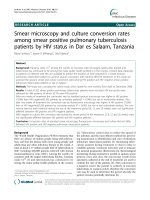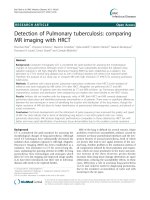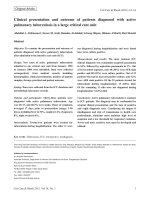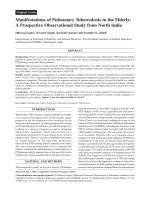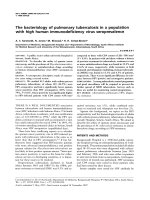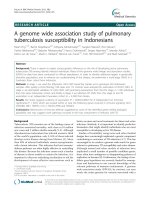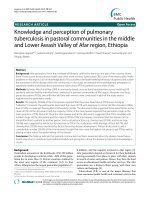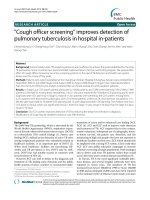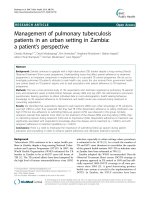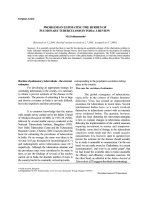Diagnosis of pulmonary tuberculosis by smear microscopy and culture in a tertiary health care facility: Biology and Medicine docx
Bạn đang xem bản rút gọn của tài liệu. Xem và tải ngay bản đầy đủ của tài liệu tại đây (434.15 KB, 6 trang )
eISSN: 09748369
Diagnosis of pulmonary tuberculosis by smear microscopy and
culture in a tertiary health care facility
Biology and Medicine
SI Khatib, MT Williamson, R Singh, JM Joshi
Accepted: 28
th
Feb 2012, Published: 6
th
Apr 2012
Volume 4, Issue 1, Page 32-36, 2012
Research Article Biology and Medicine, 4 (1): 32-36, 2012
32
BMID: AR93-BM12
www.biolmedonline.com
Diagnosis of pulmonary tuberculosis by smear microscopy and
culture in a tertiary health care facility
*SI Khatib
1,3
, MT Williamson
1
, R Singh
2
, JM Joshi
2
1
Department of Microbiology;
2
Department of Pulmonary Medicine; TN Medical College and BYL Nair
Charitable Hospital, Mumbai, India.
3
Department of Biology, Faculty of Science, Jazan University, Jazan, Kingdom of Saudi Arabia.
*Corresponding Author: ,
Abstract
Smear microscopy and culture forms the backbone of tuberculosis (TB) laboratory investigations in tertiary healthcare
facilities which have a large number of cases and financial constraints. The present study aimed to re-evaluate the
efficiency of smear microscopy and culture on Lowenstein Jensen (LJ) medium for acid fast bacilli (AFB) isolated
from patients with pulmonary tuberculosis. 210 samples were processed for detection of AFB by Ziehl Neelsen (ZN)
staining. Concentration method of N-acetly-L-cystein-NaOH was used and the samples were isolated on LJ medium.
AFB was seen in 168 (80.0%) primary smear samples. The primary smear missed 5 (11.9%) samples that were
detected by secondary smear (Sensitivity 93.45%, Specificity 88.10%, Positive predictive value (PPV) 96.91% and
Negative Predictive value (NPV) 77.08%). Growth was observed in 155 (83.30%) samples (Sensitivity 95.39%,
Specificity 70.59%, PPV 93.55%and NPV 77.42%). The values were statistically significant. The present study
reconfirms the efficiency of conventional ZN staining method and culture on LJ medium in the detection of AFB in
sputum samples of patients with pulmonary tuberculosis.
Keywords: Acid fast bacilli; culture; Lowenstein Jensen medium; pulmonary tuberculosis; smear microscopy; Ziehl
Neelsen staining.
Introduction
Millions of people have succumbed to
tuberculosis worldwide. Tuberculosis is out of
control in most of the developing countries.
Despite all the advances made in tuberculosis
control, India accounts for one-third of the cases
in Southeast Asia (WHO Report, 2009). The
Revised National Tuberculosis Control Program
(RNTCP) continues high success rates in the
detection of new cases and treatment. During
the first quarter of 2011, over 2 million
suspected cases were examined, 23.4% sputum
positive cases were diagnosed and 36.8% TB
cases were registered for treatment (Status
Report on RNTCP, 2011). Smear microscopy by
ZN staining plays an important role in case
detection in RNTCP, while culture on LJ medium
is the gold standard. With the emergence of
MDR and XDR TB, case detection and
identification retains a very high priority. With
this study we wish to emphasize the efficiency of
ZN staining method and Culture on LJ medium.
Materials and Methods
The study was approved by the local ethical
committee and Informed consent was obtained
from patients. A total of 210 adult patients
suspected to suffer from Pulmonary
Tuberculosis on the basis of their clinical and
radiological presentations were enrolled. Old
cases of Pulmonary Tuberculosis were also
included in our study. The clinical criteria and
patient history was taken. Children and cases of
Extra-pulmonary TB were excluded from the
study. Early morning sputum samples from
patients suspected to suffer from pulmonary
tuberculosis were collected in sterile wide mouth
containers and examined. Instructions were
given to the patients before sputum collection.
Sputum samples were processed immediately
after receiving it from the patients. A smear was
made on a glass slide and stained by ZN
staining technique. The smear was checked for
acid-fast bacilli under oil immersion and reported
according to the Revised National Tuberculosis
Control Program (RNTCP laboratory module –
1999).
Negative = No AFB seen per 100 oil immersion fields.
Scanty = 1–9 AFB per 100 oil immersion fields. Give the exact number.
1+ = 10–99 bacilli per 100 oil immersion fields.
2+ = 1–10 AFB per oil immersion field.
3+ = More than 10 AFB per oil immersion fields.
Research Article Biology and Medicine, 4 (1): 32-36, 2012
33
BMID: AR93-BM12
Sputum samples were decontaminated
using N – acetyl – L – cysteine + 2 % NaOH and
concentrated by centrifugation at 2500 – 3000
rpm. Samples were processed and inoculated
on Lowenstein Jensen medium slants. They
were incubated for about 8 to 10 weeks at 37
o
C
and checked for growth every week. Colony
characteristics were studied (Kent and Kubica,
1985).
The results and observations were
subjected to statistical analysis (Pearson Chi-
square test, Continuity Correction, Measurement
of Agreement (Kappa) and Likelihood Ratio)
wherever necessary. Statistical analysis was
done using SPSS software version 13 (SPSS
Inc., Chicago, Illinois).
Results
210 patients were enrolled in this study. 185
(88.1 %) patients had a previous history of TB.
168 (80.0 %) samples showed the presence of
acid-fast bacilli in the primary smear. 42 (20.0
%) did not show the presence of AFB. 2 + smear
grading was most commonly seen followed by 1
+ smear grade (Table 1). After decontamination
and concentration, there were 48 (22.9 %)
smear negative samples.
Table 1: Primary & Secondary Smear among the cases.
Primary Smear
Number (%)
Secondary Smear
Number (%)
Negative
42 (20)
48 (22.9)
Positive
1+
2+
3+
Scanty
168 (80)
50 (23.8)
60 (28.6)
36 (17.1)
22 (10.5)
162 (77.1)
Total
210 (100)
Table 2: Primary Smear result compared with Secondary Smear.
Primary Smear result
Secondary Smear
Total
Positive
Negative
Positive
No.
157
11
168
%
93.50%
6.50%
100.00%
Negative
No.
5
37
42
%
11.90%
88.10%
100.00%
Total
No.
162
48
210
%
77.10%
22.90%
100.00%
Chi-square Test applied
Value
df
P-value
Association is-
Pearson Chi-Square
126.720
1
2.14E-29
Significant
Continuity Correction
122.137
1
2.15E-28
Significant
Likelihood Ratio
113.870
1
1.39E-26
Significant
Measurements
Value
95 % Confidence Interval
Sensitivity
93.45%
88.91%
96.51%
Specificity
88.10%
75.57%
95.50%
Positive Predictive Value
96.91%
92.94%
98.99%
Negative Predictive Value
77.08%
62.73%
87.95%
Likelihood Ratio
7.850
Symmetric measures among the cases
Measure of Agreement
Value
Asymp. Std. Error
Approx. T
Approx. Sig.
Kappa
0.774
0.054
11.257
2.14E-29
Research Article Biology and Medicine, 4 (1): 32-36, 2012
34
BMID: AR93-BM12
5 (11.9 %) samples that were missed in
the primary smear were detected by secondary
smear. While 11 (6.50 %) samples that were
primary smear positive were missed in
secondary smear. The Sensitivity and Specificity
was found to be 93.45% and 88.10 % for
Primary and secondary smear respectively. The
Positive predictive value and Negative Predictive
value was 96.91 % and 77.08 %. The values
were statistically significant (Table 2).
Growth was observed in 155 (73.8 %)
samples (n = 186), Contamination was found in
24 (11.4 %) samples and 31 (14.8%) samples
did not show growth on LJ medium. Growth was
seen in 145 (95.4 %) smear positive samples
while 7 (4.6 %) smear positive samples did not
show growth. Growth was observed in 10 (29.4
%) smear negative samples (Sensitivity 95.39 %
and Specificity 70.59 %). The Positive predictive
value and Negative Predictive value was 93.55
% and 77.42 % respectively. The values were
statistically significant (Table 3).
Table 3: Smear results compared with Culture on LJ medium.
Smear result
Culture (LJ) (n = 186)
Total
Growth
No growth
Positive
No.
145
7
152
%
95.40%
4.60%
100.00%
Negative
No.
10
24
34
%
29.40%
70.60%
100.00%
Total
No.
155
31
186
%
83.30%
16.70%
100.00%
Chi-square Test applied
Value
Df
P-value
Association is-
Pearson Chi-Square
87.098
1
1.03E-20
Significant
Continuity Correction
82.412
1
1.11E-19
Significant
Likelihood Ratio
69.650
1
7.08E-17
Significant
Measurements
Value
95 % Confidence Interval
Sensitivity
95.39%
90.75%
98.13%
Specificity
70.59%
52.52%
84.88%
Positive Predictive Value
93.55%
88.44%
96.86%
Negative Predictive Value
77.42%
58.94%
90.40%
Likelihood Ratio
3.243
Discussion
The menace of Tuberculosis is age old.
Concerns are mounting over the rise in the
number of TB cases and more worryingly, drug
resistant TB cases. Despite the fact that highly
effective drugs are available today, the problem
of this infectious disease is increasing. This
situation has been worsened by factors such as
delayed diagnosis, high mortality, deteriorating
social conditions, emergence of HIV / AIDS, and
the poor implementation of DOTS (Directly
Observed Treatment, Short – course) strategies.
Current evidence suggests that the high levels
of project management needed for the success
of DOTS strategies are not being achieved.
Passive case finding is the mainstay of
case finding in most developing countries. This
relies heavily on sputum examination by smear
and culture, chest radiology and tuberculin skin
testing. Under ideal circumstances, a test for
tuberculosis should be 100 % sensitive (no false
negative) and 100 % specific (no false positive),
should distinguish between infection and
disease and give a rough idea of bacillary load.
Research Article Biology and Medicine, 4 (1): 32-36, 2012
35
BMID: AR93-BM12
No such test exists and all existing diagnostic
methods reflect compromises of the above ideal.
Hence periodic evaluation studies of existing
diagnostic methods are a continuing necessity.
The acid-fast smear has been used as
an aid in the diagnosis of mycobacterial disease
for many years. It is the simplest procedure
currently available to detect AFB in clinical
samples by ZN staining. As seen in Table 1, 80
% of the samples showed the presence of AFB
in the primary smear. Most of the primary
smears showed 2 + grading (28.6 %) followed
by 1 + (23.8 %) and 3 + (17.1 %). After
decontamination and concentration by NALC-
NaOH method, 77.1 % samples were AFB
positive. 11 samples which were primary smear
positive were missed in the secondary smear.
This can be attributed to the fact that
decontamination / concentration could lead to a
decrease in AFB numbers. Thus the secondary
smear must have been negative. The values
were statistically significant. (P = 2.14E-29).
There was an 11.9 % increase in AFB positivity
in the secondary smear. This can be attributed
to the fact that the amount of AFB in the sputum
must be very less and only after concentration
the AFB could be seen (Table 2).
The sensitivity of smear in our study
was found to be 93.45 % and Specificity was
88.10 %. The PPV was 96.91 % and the NPV
was 77.08 %. Boyd and Marr (1975)
found the
Sensitivity to be only 22 %, and Specificity was
100 %, while Burdash et al. (1976)
found
Sensitivity to be 42.7 % and Specificity to be
99.9 %. Rickman and Moyet (1980) studied the
co-relation of sensitivity with that of centrifugal
force and observed Sensitivity of 82.4 % at an
RPM of 3,800 g and Specificity to be 97.4 %.
These observations were comparatively similar
to ours. An increase in sensitivity can be
misleading as it may be accompanied by a
decrease in the true positivity, and an increase
in the relative number of false positives. This
can be explained by the large number of treated
patients who provided specimen that were
smear positive but culture negative.
Though the growth of mycobacteria is
slow, culture remains the ‘Gold Standard’ for
definitive diagnosis of tuberculosis since it gives
positive results with comparatively fewer
organisms, and hence permits identification and
drug susceptibility tests to be done on the
culture isolate (Davies et al., 1996). Growth was
seen in 73.8 % samples while contamination
was found in 11.4 % samples. All the isolates
were identified as that of M. tuberculosis using
standard biochemical tests.
Though stringent aseptic precautions
and suitable decontamination techniques were
followed, a large number (11.4 %) of the
samples were contaminated. Paramsivan et al.
(1987) reported a contamination rate of 4 %.
This contamination could be attributed to the fact
that LJ medium, being an extremely rich and
notorious medium, supports the growth of a
small number of contaminating bacteria. It has
been quoted by Jenkins (1994) that 2 – 3 % of
culture could be lost due to contamination,
indicating that the treatment procedure is neither
too harsh nor too moderate.
Growth was observed in 29.4 % smear
negative samples thereby indicating the
superiority of culture over smear microscopy,
whereas no growth was observed in 4.6 %
smear positive samples. All these cases were on
AKT, indicating that the bacilli seen in the
primary smears were killed bacilli. The
Sensitivity and Specificity was found to be 95.39
% and 70.59 % respectively (PPV 93.55 % and
NPV 77.42%). The observations seen in Table 3
were statistically significant (P = 1.03E-20).
Conclusion
The present study reconfirms the use of
conventional ZN staining method and culture on
LJ medium in the detection of AFB in sputum
samples of patients with pulmonary tuberculosis
in tertiary healthcare facilities which have a large
number of cases and financial constraints.
Ethical Approval
The study was approved by the institutional
ethics committee of TN Medical College and
BYL Nair Charitable Hospital, Mumbai, India.
Conflict of Interests
Authors declare that they have no conflicting
interests with regard to the study.
Acknowledgement
This work was supported by Nair Golden Jubilee
Research Fund (NGJRF).
References
Boyd JC, Marr JJ, 1975. Decreasing reliability of acid
fast smear technique for detection of tuberculosis.
Annals of Internal Medicine, 82: 489–490.
Research Article Biology and Medicine, 4 (1): 32-36, 2012
36
BMID: AR93-BM12
Burdash NM, Manos JP, Ross D, Bannister ER, 1976.
Evaluation of the acid fast smear. Journal of Clinical
Microbiology, 4(2): 190-191.
Davies PDO, Girling DJ, Grang JM, 1996.
Tuberculosis in Oxford Textbook of Medicine, Vol. 1.
Editors: Weatherall DJ, Ledingham JGG, Warrell DA.
3
rd
Edition. Oxford Medical.
Jenkins PA, 1994. The Microbiology of Tuberculosis
in Clinical TB. Ed: Davies PDO. Chapman and Hall.
4–15.
Kent PT, Kubica GP, 1985. Public Health
Mycobacteriology. A Guide for the Level III
Laboratory. U.S. Department of Health and Human
Services, Centers for Disease Control, Atlanta, GA.
Paramsivan CN, Kumar V, Alexander C, Venkatesan
P, Somasundaram PR, Prabhakar R, 1987. Use of
multiple media for the cultivation of mycobacteria from
specimen other than sputum. Indian Journal of
Medical Research, 86: 290–294.
Revised National Tuberculosis Control Program
(RNTCP), 1999. Module for Laboratory Technicians.
Central TB Division, Directorate General of Health
Services, Ministry of Health and Family welfare, New
Delhi.
Rickman TW, Moyet NP, 1980. Increased sensitivity
of acid fast smears. Journal of Clinical Microbiology,
11: 618.
Status Report on RNTCP, 2011. Indian Journal of
Tuberculosis, 58: 132-135.
World Health Organization, 2009. Global tuberculosis
control. WHO Report, WHO/HTM/TB/2009.
